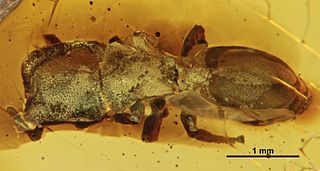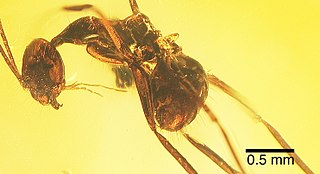
Termitaradus mitnicki is an extinct species of true bug in the family Termitaphididae known only from early Miocene Burdigalian stage Dominican amber deposits on the island of Hispaniola.

Cephalotes caribicus is an extinct species of ant in the subfamily Myrmicinae known from two Middle Miocene fossils found in amber on Hispaniola. At the time of description C. caribicus was one of nine ant species placed in the Cephalotespinelii clade.
Hyptia deansi is an extinct species of ensign wasp in the family Evaniidae known from a solitary Late Oligocene to Early Miocene fossil found in Mexico. H. deansi is the only species in the genus Hyptia to have been described from fossils and the only ensign wasp described from Mexican amber.
Schwenckfeldina archoica is an extinct species of dark winged fungus gnat in the family Sciaridae known from a solitary Late Oligocene to Early Miocene fossil found in Mexico. S. archoica is the only species in the genus Schwenckfeldina to have been described from fossils found in Mexican amber.
Mastotermes electromexicus is an extinct species of termite in the family Mastotermitidae known from a group of Late Oligocene to Early Miocene fossils found in Mexico. M. electromexicus is the only species in the genus Mastotermes to have been described from fossils found in Mexican amber and was the first member of the genus described from the New World. The only living species of Mastotermes is Mastotermes darwiniensis which is found in tropical regions of Northern Australia.
Termitaradus dominicanus is an extinct species of termite bug in the family Termitaphididae known from a Miocene fossil found on Hispaniola. T. dominicanus is the third species in the genus Termitaradus to have been described from fossils found in Dominican amber after Termitaradus avitinquilinus and Termitaradus mitnicki.
Termitaradus protera is an extinct species of termite bug in the family Termitaphididae known from several Late Oligocene to Early Miocene fossils found in Mexico. T. protera is the only species in the extant genus Termitaradus to have been described from fossils found in Mexican amber and is one of four species from new world amber; the others are Termitaradus avitinquilinus, Termitaradus dominicanus and Termitaradus mitnicki. T. protera was also the first termite bug described from the fossil record.
Termitaradus avitinquilinus is an extinct species of termite bug in the family Termitaphididae known from several possibly Miocene fossils found in the Dominican Republic. T. avitinquilinus is the first species in the genus Termitaradus to have been described from fossils found in Dominican amber and is one of four species from New World amber, the others being Termitaradus protera, Termitaradus dominicanus and Termitaradus mitnicki.
Hymenaea mexicana is an extinct legume species in the family Fabaceae described from a series of isolated fossil petals, leaflets, and amber. The species is known from a group of Late Oligocene to Early Miocene locations in southern Mexico. It is one of two extinct Hymenaea species placed close to the living species Hymenaea verrucosa and along with Hymenaea allendis, is one of the two extinct species which have been found in Mexican amber.
Hymenaea allendis is an extinct legume species in the family Fabaceae described from a single isolated fossil flower in amber. The species is known from a Late Oligocene to Early Miocene location in southern Mexico. Unlike the coeval extinct species Hymenaea mexicana and Hymenaea protera which are placed closer to the living species Hymenaea verrucosa of Africa, H. allendis is closer in relation to the neotropical species of Hymenaea.
Aphaenogaster praerelicta is an extinct species of ant in the subfamily Myrmicinae known from a solitary Late Oligocene to Early Miocene fossil found in Mexico. At the time of description A. praerelicta was one of three Aphaenogaster species known from Mexico.
Apterostigma electropilosum is an extinct species of ant in the subfamily Myrmicinae known from a single possibly Miocene fossil found on Hispaniola. A. electropilosum is one of only two species of the ant genus Apterostigma and one of five attini species to have been described from fossils found in Dominican amber.

Zatania electra is an extinct species of ant in the subfamily Formicinae known from three possibly Miocene fossils found on Hispaniola. Z. electra is one of several Zatania species found in the Greater Antilles.
Dicromantispa electromexicana is an extinct species of mantidfly in the neuropteran family Mantispidae known from a fossil found in North America.
Dicromantispa moronei is an extinct species of mantidfly in the neuropteran family Mantispidae known from a fossil found in the Caribbean.
Parastemmiulus is an extinct genus of millipede in the family Stemmiulidae known from a fossil found in Mexico. There is one described species in the genus, Parastemmiulus elektron. The species is one of three millipedes described from Mexican amber, and the oldest Stemmiulidae fossil species as of 2013.

Maatidesmus is an extinct genus of millipede in the family Chelodesmidae known from a fossil found in North America. There is one described species in the genus, Maatidesmus paachtun, one of three millipedes described from Mexican amber.

Anbarrhacus is an extinct genus of millipede in the family Platyrhacidae known from a fossil found in North America. There is one described species in the genus, Anbarrhacus adamantis, which is one of three millipedes described from Mexican amber.

Mexican amber, also known as Chiapas Amber is amber found in Mexico, created during the Early Miocene and middle Miocene epochs of the Cenozoic Era in southwestern North America. As with other ambers, a wide variety of taxa have been found as inclusions including insects and other arthropods, as well as plant fragments and epiphyllous fungi.

Gyaclavator is an extinct genus of lace bug in the family Tingidae known from a fossil found in North America. The genus contains a single species, Gyaclavator kohlsi.






